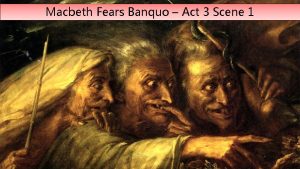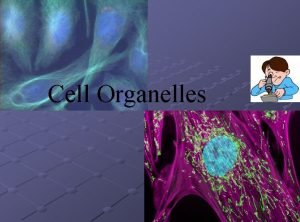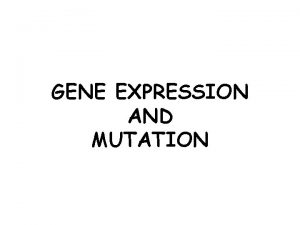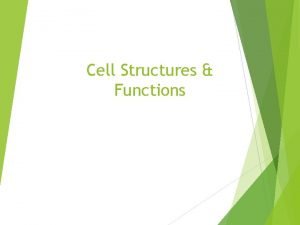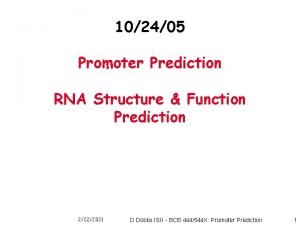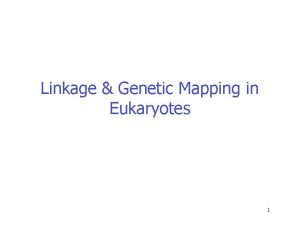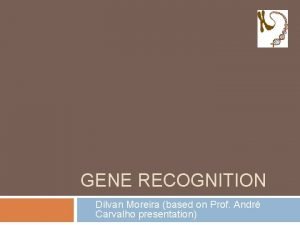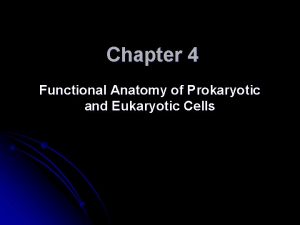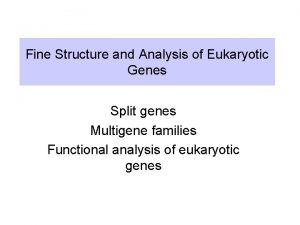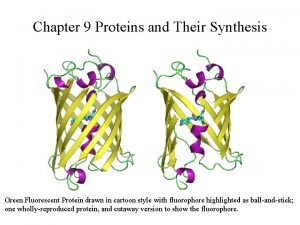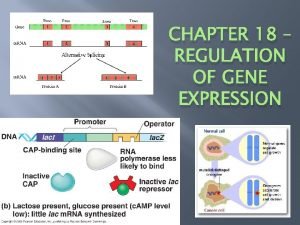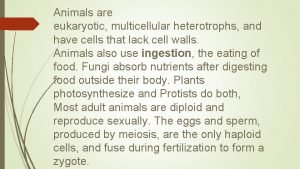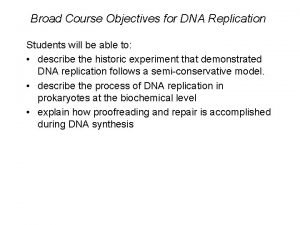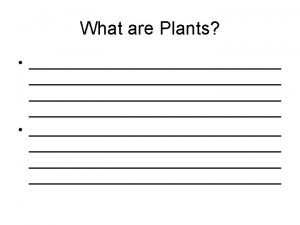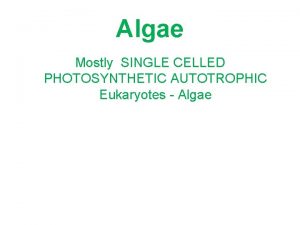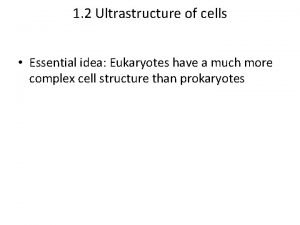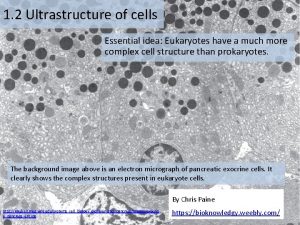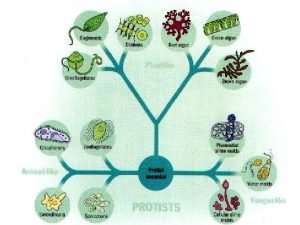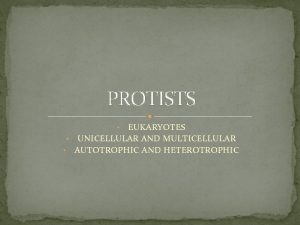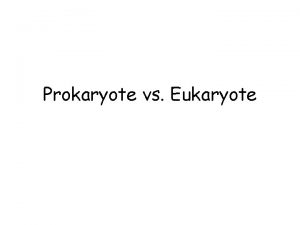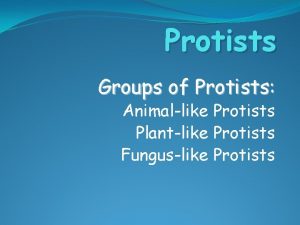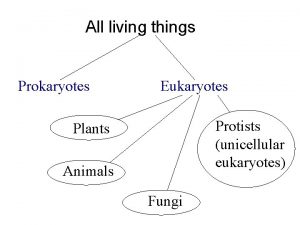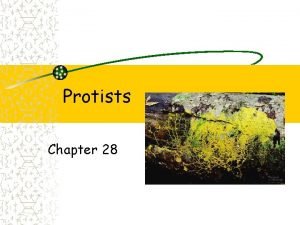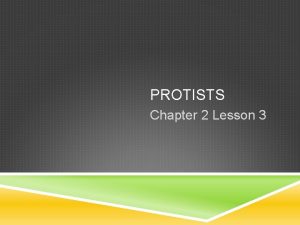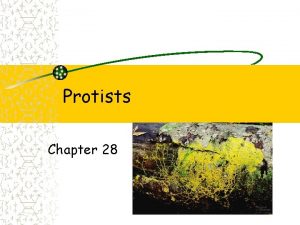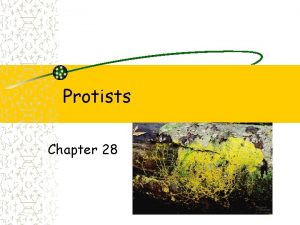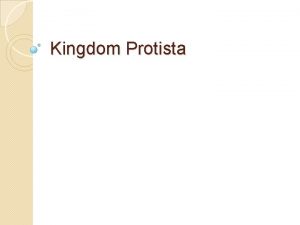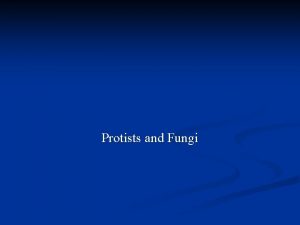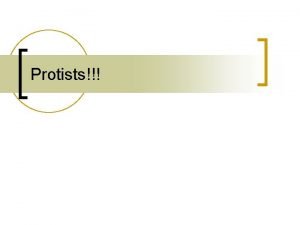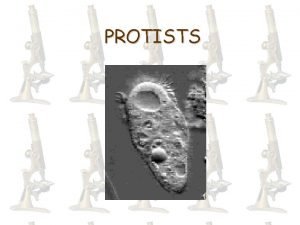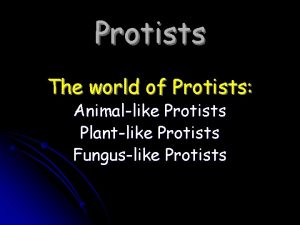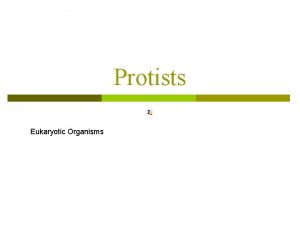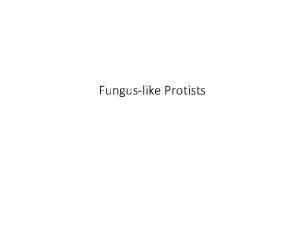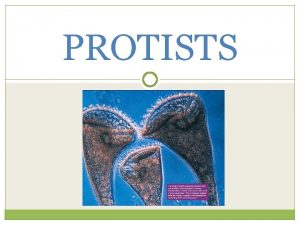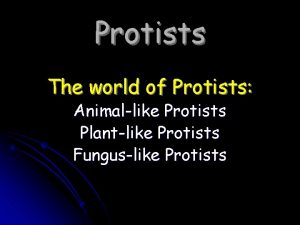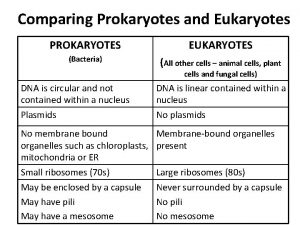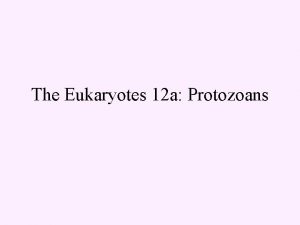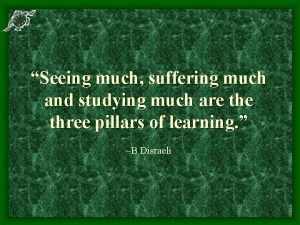Protists Protists are eukaryotes and thus are much





































- Slides: 37

Protists • Protists are eukaryotes and thus are much more complex than the prokaryotes. • The first eukaryotes were unicellular. • Not only were they the predecessor to the great variety of modern protists, but also to all other eukaryotes plants, fungi, and animals.

• Protista, as a kingdom, was defined mostly by exclusion from the • definitions of plants, • fungi, or animals. • However, this created a group ranging from singlecelled microscopic members, complex giants like seaweeds.

18. The most complicated of all cells on Earth are in what kingdom? Explain why:

Protists are the most diverse of all eukaryotes • Protists are so diverse that few general characteristics can be cited without exceptions. • **While unicellular protists would seem to be the simplest eukaryotic organisms, at the cellular level they are the most elaborate of all cells. ** • A single cell must perform all the basic functions performed by the collective of specialized cells in plants and animals.

19. What are three categories of protists?

• Protists can be divided into three ecological categories: • 1. Protozoa - ingestive, animal-like protists • 2. Absorptive- fungus-like protists • 3. Algae - photosynthetic, plant-like protists.

20. What is the definition of plankton?

• Protists are found almost anywhere there is water. • This includes oceans, ponds, and lakes, but also damp soil, leaf litter, and other moist terrestrial habitats. • In aquatic habitats, protists may be bottom-dwellers attached to rocks and other anchorages or creeping through sand silt. • Protists are also important parts of the plankton, communities of organisms that drift passively or swim weakly in the water and are the bases of most marine and freshwater food chains.

Mitochondria and plastids evolved from endosymbiotic bacteria • The evidence is now overwhelming that the eukaryotic cell originated from a symbiotic coalition of multiple prokaryotic ancestors. • The theory of serial endosymbiosis proposes that mitochondria and chloroplasts were formerly small prokaryotes now living within larger cells. • Cells that live within other cells are called endosymbionts.

21. Chloroplast and mitochondria are thought to have originated how? List two pieces of evidence that supports this:

• Several lines of evidence support a close similarity between bacteria and the chloroplasts and mitochondria of eukaryotes. • 1. These organelles and bacteria are similar is size. • 2. Enzymes and transport systems in the inner membranes of chloroplasts and mitochondria resemble those in the plasma membrane of modern prokaryotes. • 3. Replication by mitochondria and chloroplasts resembles binary fission in bacteria.

• 4. The single circular DNA in chloroplasts and mitochondria lack histones and other proteins, as in most prokaryotes. • 5. Both organelles have their own transfer RNAs, ribosomes, and other molecules for transcription of their DNA and translation of m. RNA into proteins. • 6. The ribosomes of both chloroplasts and mitochondria are more similar to those of prokaryotes than to those in the eukaryotic cytoplasm that translate nuclear genes.

Important Protists: • 1. Giardia • 2. Euglena • 3. Dinoflagellates • 4. Plasmodium • 5. Paramecium • 6. OOmycotes • 7. Diatoms • 8. Brown Algae / Kelp • 9. Red Algae • 10. Green Algae • 11. Amoeba (Entamoeba histolitica) • 12. Slime Mold

• Giardia lamblia is a simple protist that belongs to a group of primitive protists that have no mitochondria • Giardia lamblia is a parasite that infects the human intestine …cause bad month long diarrhea. • The most common method of acquiring Giardia is by drinking water contaminated with feces containing the parasite in a dormant cyst stage.

• Several protistan groups, including the euglenoids and, use flagella for locomotion. • Euglena is characterized by: flagella for movement, an eyespot to detect light, and the presence of chloroplasts.

• The dinoflagellates are abundant components of the phytoplankton (photosynthesizing plankton) that are suspended near the water surface. • Dinoflagellates and other phytoplankton form the foundation of most marine and many freshwater food chains.

• Dinoflagellate blooms, characterized by explosive population growth, cause red tides in coastal waters. • The blooms are brownish-red or pinkish-orange because of the predominant pigments in the plastids. • Toxins produced by some red-tide organisms have produced massive invertebrate and fish kills. • These toxins can be deadly to humans as well.


22. Plasmodium is a protist that causes what disease? How is this disease transmitted to humans?

• Plasmodium, the parasite that causes malaria, spends part of its life in mosquitoes and part in humans. About 300 million people are infected with malaria in the tropics, and up to 2 million die each year

• In a Paramecium, cilia along the oral groove draw in food that are engulfed by phagocytosis. • Like other freshwater protists, the hyperosmotic Paramecium expels accumulated water from the contractile vacuole.

• The oomycotes are absorptive protists that include water molds, white rusts, and downy mildews. • They look like fungi. Why not in that kingdom? • The hyphae (thin branching filaments for absorption) are composed of a different substance than are the hyphae of true fungi

• Diatoms have unique glasslike walls composed of hydrated silica embedded in an organic matrix. • The wall is divided into two parts that overlap like a shoe box and lid.

• Brown algae are the largest and most complex algae. • Most brown algae are multicellular. • Most species are marine. • They are also known as kelp or seaweed • Brown algae are especially common along temperate coasts in areas of cool water and adequate nutrients. • They owe their characteristic brown or olive color to accessory pigments in the plastids.

23. Name some products made from brown algae

• Giant brown algae, known as kelps, form forests in deeper water. • They may be 60 m long. Many seaweeds are eaten by coastal people A variety of gelforming substances are extracted for commercial food production. Carageenan (makes ice cream smooth/thick) is used as a thickener in food

Red Algae The plastids of red algae evolved from endosymbiosis of cyanobacteria (red bact) • Red algae (Rhodophyta) are the most common seaweeds in the warm coastal waters of tropical oceans • Some red algae inhabit deeper waters than other photosynthetic eukaryotes. • Their photosynthetic pigments allow some species to absorb those wavelengths (blues and greens) that penetrate down to deep water

Red Algae

24. What are the evolutionary ancestors that gave rise to land plants?

• Green algae: named for their green chloroplasts. • These chloroplasts are similar in sructure and pigment composition to those of plants. • The common ancestor of green algae and plants probably had chloroplasts derived from cyanobacteria by endosymbiosis. • Green Algae are especially closely related to land plants.

• Large size and complexity in green algae has evolved by three different mechanisms: (1) formation of colonies of individual cells (Volvox) (2) the repeated division of nuclei without cytoplasmic division to form multinucleate filaments (Caulerpa)

• Amoebas use pseudopodia, cellular extensions, to move and often to feed These are the most animal like protists • Most species are heterotrophs that actively hunt bacteria, other protists, and detritus. Pseudopodium can emerge from anywhere in the cell surface. To move, an amoeba extends a pseudopod, anchors its tip, and then streams more cytoplasm into the pseudopodium.

• Amoebas inhabit freshwater and marine environments • They may also be abundant in soils. • Most species are free-living heterotrophs. • Some are important parasites. • These include Entamoeba histolytica which causes amoeboid dysentery in humans. • These organisms spread via contaminated drinking water, food, and eating utensils.

• Slime Molds (“fungus animals”) are neither fungi nor animals, but protists. • Any resemblance to fungi is analogous, not homologous, for their convergent role in the decomposition of leaf litter and organic debris. • Slime molds feed and move via pseudopodia, like amoeba, but comparisons of protein sequences place slime molds relatively close to the fungi and animals.

• The slime molds are brightly pigmented, heterotrophic organisms. • The feeding stage is an amoeboid mass, the plasmodium, that may be several centimeters in diameter. • The plasmodium is not multicellular, but a single mass of cytoplasm with multiple nuclei.

Within the cytoplasm, cytoplasmic streaming distributes nutrients and oxygen throughout the plasmodium. • The plasmodium phagocytises food particles from moist soil, leaf mulch, or rotting logs. .

Funny Plankton Not funny Plankton
 Macbeth act 3 scene 1
Macbeth act 3 scene 1 Antigentest åre
Antigentest åre Decaffeinated hot chocolate
Decaffeinated hot chocolate To whom much is given much is required meaning
To whom much is given much is required meaning How much is too much plagiarism
How much is too much plagiarism Is animal cell prokaryotic or eukaryotic
Is animal cell prokaryotic or eukaryotic Diff between prokaryotes and eukaryotes
Diff between prokaryotes and eukaryotes Prokaryotes and eukaryotes
Prokaryotes and eukaryotes Cytoskeletal protein
Cytoskeletal protein Multiple choice questions on prokaryotes and eukaryotes
Multiple choice questions on prokaryotes and eukaryotes Gene prediction in prokaryotes and eukaryotes
Gene prediction in prokaryotes and eukaryotes Repressible operon
Repressible operon Chi square test for linkage
Chi square test for linkage Prokaryotes and eukaryotes
Prokaryotes and eukaryotes Which organisms are prokaryotes
Which organisms are prokaryotes Anatomy of prokaryotes and eukaryotes
Anatomy of prokaryotes and eukaryotes When to use hence and thus
When to use hence and thus Images of multicellular organisms
Images of multicellular organisms Rho independent termination
Rho independent termination Prokaryotic vs eukaryotic transcription
Prokaryotic vs eukaryotic transcription Characteristics of eukarya
Characteristics of eukarya Fine structure analysis of eukaryotes
Fine structure analysis of eukaryotes Translation in bacteria vs eukaryotes
Translation in bacteria vs eukaryotes Prokaryotes vs eukaryotes gene regulation
Prokaryotes vs eukaryotes gene regulation Cloroplasto
Cloroplasto All animals are multicellular heterotrophs
All animals are multicellular heterotrophs Prokaryotic and eukaryotic cells
Prokaryotic and eukaryotic cells Linear chromosomes in eukaryotes
Linear chromosomes in eukaryotes Are plants multicellular eukaryotes
Are plants multicellular eukaryotes Transcription
Transcription Types of dna polymerase in eukaryotes
Types of dna polymerase in eukaryotes Eukaryotic vs prokaryotic cells
Eukaryotic vs prokaryotic cells Spirogyra unicellular or multicellular
Spirogyra unicellular or multicellular Eukaryotes main idea
Eukaryotes main idea Eukaryotes main idea
Eukaryotes main idea Polyphyletic group
Polyphyletic group Are protists autotrophic or heterotrophic
Are protists autotrophic or heterotrophic Prokaryotes vs eukaryotes
Prokaryotes vs eukaryotes
